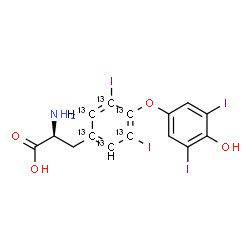L-Thyroxine-13c6
Modify Date: 2024-01-03 11:03:34

L-Thyroxine-13c6 structure
|
Common Name | L-Thyroxine-13c6 | ||
|---|---|---|---|---|
| CAS Number | 720710-30-5 | Molecular Weight | 782.826 | |
| Density | 2.6±0.1 g/cm3 | Boiling Point | N/A | |
| Molecular Formula | C913C6H11I4NO4 | Melting Point | N/A | |
| MSDS | N/A | Flash Point | 9℃ | |
| Symbol |



GHS02, GHS06, GHS08 |
Signal Word | Danger | |
Use of L-Thyroxine-13c6L-Thyroxine-13C6 is the 13C labeled L-Thyroxine[1]. L-Thyroxine (Levothyroxine;T4) is a synthetic hormone for the research of hypothyroidism. DIO enzymes convert biologically active thyroid hormone (Triiodothyronine,T3) from L-Thyroxine (T4)[2]. |
| Name | L-Thyroxine-[L-Tyr-ring-13C6] hydrochloride |
|---|---|
| Synonym | More Synonyms |
| Description | L-Thyroxine-13C6 is the 13C labeled L-Thyroxine[1]. L-Thyroxine (Levothyroxine;T4) is a synthetic hormone for the research of hypothyroidism. DIO enzymes convert biologically active thyroid hormone (Triiodothyronine,T3) from L-Thyroxine (T4)[2]. |
|---|---|
| Related Catalog | |
| In Vitro | Stable heavy isotopes of hydrogen, carbon, and other elements have been incorporated into drug molecules, largely as tracers for quantitation during the drug development process. Deuteration has gained attention because of its potential to affect the pharmacokinetic and metabolic profiles of drugs[1]. |
| References |
| Density | 2.6±0.1 g/cm3 |
|---|---|
| Molecular Formula | C913C6H11I4NO4 |
| Molecular Weight | 782.826 |
| Flash Point | 9℃ |
| Exact Mass | 782.706787 |
| Index of Refraction | 1.795 |
| Storage condition | ?20°C |
| Symbol |



GHS02, GHS06, GHS08 |
|---|---|
| Signal Word | Danger |
| Hazard Statements | H225-H301 + H311 + H331-H370 |
| Precautionary Statements | P210-P260-P280-P301 + P310-P311 |
| Hazard Codes | F,T |
| Risk Phrases | 11-23/24/25-39/23/24/25 |
| Safety Phrases | 7-16-36/37-45 |
| RIDADR | UN1230 - class 3 - PG 2 - Methanol, solution |
| EINECS 200-659-6 |